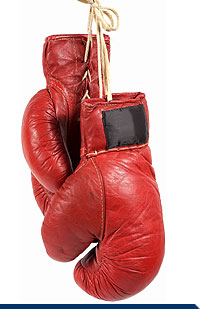 |
Choosing Your Right
Boxing Glove Size and Handwraps
When picking out a pair
of boxing gloves, choosing one that best fits
your hand is not exactly the right criteria
you should follow. Try putting on handwraps
underneath the gloves. 120" handwraps
are right for small hands. For medium to large
hands, you will want 170" or longer.
Why bother with handwraps?
When boxing, you will need to support your
wrist and thum to protect your bones and tendons
from injury. It is important that you always
wrap your hands before working out or boxing.
|
|
|
BOXING FOR
BETTER HEALTH: Do
you want the strength of undefeated boxer
Laila Ali or the body of heavyweight champion
Lennox Lewis? [ More
]
A KNOCKOUT WORKOUT:
Here's how you can do
it at home. [ More
] |
 |
|
Boxing Tips
Boxing For Better Health - Boxing
Exercise Tips
Ebony, April, 2001
Do you want the strength of undefeated boxer Laila
Ali or the body of heavyweight champion Lennox Lewis?
You don't have to step into the ring to get a great
workout. Boxing classes are becoming the norm in
many health clubs and fitness centers across the
country.
Participants are learning what boxing enthusiasts
have known for years--that boxers are some of the
most highly conditioned athletes competing in sports
today, and that if you follow some simple procedures,
you can build stamina, tone your muscles and burn
calories.
"Boxing is one of the best exercises. You work
all of the muscles in the body," says Terrence
Blackmoore, a trainer at Gleason's Gym in Brooklyn.
"More people are becoming interested in the
sport as exercise. Women are crazy for boxing right
now ... It's a whole-body workout."
For the most part, women are behind the increased
interest in the sport, experts say. As more women
get their hands and wrists wrapped and lace up the
gloves in amateur and professional boxing, health-conscious
women are beginning to use boxing for fitness.
"I always wanted to learn kickboxing for fitness,"
says Mea Robinson-Davis, who takes a class at Chicago's
New City YMCA. "It's an excellent cardiovascular
workout, and you learn a skill."
There is a difference between boxing professionally
and working out alongside your fellow classmates
in the safety of a health club. Although professionals
are at greater risk for head and neck injuries,
most health and fitness experts urge newcomers to
confine their fisticuffs to the gyms, where boxing
classes will help to improve your cardiovascular
fitness, flexibility and coordination.
"I think anybody who tries it knows that it
takes a lot more work than anything else,"
says Terry Southerland, a trainer and boxer who
teaches boxing classes at Crunch Fitness in New
York. "Nothing takes more energy."
For those of you who are thinking about boxing for
better health, here's a little primer to see if
you're up to the challenge. As with any exercise
program, consult with your doctor before starting.
And if you want a more intense workout, you may
want to head to your local gym and hire a professional
trainer to put you through your paces.
WARM UP
As with any workout, you'll need to warm up to get
your heart pumping. Jump rope for 10-15 minutes.
Start off on the balls of your feet, tuck your elbows
and use your wrists to rotate the rope. When you're
comfortable jumping with both feet at the same time,
shift your weight from each foot with each rotation.
Don't worry if your technique doesn't match that
of the professionals. You'll get the hang of it.
If you need a break, rest for one minute every three
to four minutes, and then begin again.
THE BASICS
Now that you've warmed up, it's time to learn the
basics. The proper form and technique are key in
making sure that you get the best workout possible
while avoiding injuries.
A proper stance allows you to throw harder punches
and get a better workout. Stand with your feet hip-width
apart and knees slightly bent. Balance on the balls
of your feet and take a natural step forward with
your left foot (step forward with your right foot
if you're left-handed). Bring your hands up to cheekbone
level, keep elbows tucked and your chin down. Remember
to keep your abs tight, as if you were doing a sit-up.
Stay light on your feet as you move around, and
lightly bounce, shifting your weight back and forth.
Keep your knees soft throughout the workout.
There are six punches in the book of boxing, says
Blackmoore, who has trained celebrities like Sean
(Puffy) Combs. It's all about the coordination of
body movement. The two that are probably easiest
to learn are the jab and the uppercut. When throwing
these basic punches, never lock your elbow, because
that can cause serious joint injuries.
The jab is a quick punch with a snap to it and is
most often used to set up other punches. Push off
the ball of your back foot, take a small step forward
with your front foot and explode your left fist
out. From the left-handed stance, you'll jab with
your right fist. Rotate your shoulders, palm facing
down, and extend your punch. Don't lock your elbow.
Snap your fist back into position quickly as you
step back into your original stance.
The uppercut is a punch that lands with your palm
facing your body and your fist pointed up toward
the ceiling. Bend your knees and tuck the elbow
of your punching arm into your hip. Thrust with
your hips and drive your punch upward, keeping your
elbow bent at a 90-degree angle or greater.
If your gym doesn't have a heavy bag, you can shadow
box with an imaginary opponent. While you don't
need gloves for shadow boxing, the extra weight
only adds to your workout.
Your workout should consist of 3- to 4-minute rounds,
where you do combination punches, move around the
bag or room if you're shadow boxing and concentrate
on your footwork, says Southerland. If you get tired,
slow your pace, take deep breaths and keep going.
The stronger you get, the longer you'll be able
to go.
COOL DOWN
For a 3-minute cool down, slowly shadow box, in
front of a mirror if possible, checking your form
and technique. Practice all of your punches, slowly
reviewing everything you've worked on as your heart
rate slows and your body begins to cool. Always
remember to stretch before and after your workouts.
And when you've been at it for a little while, you'll
begin to notice a difference, say trainers and participants.
"The biggest benefit for most people is a higher
confidence level," Southerland says. "They're
a lot more self-confident after they've taken it
for a little while."
COPYRIGHT 2001 Johnson Publishing Co.
COPYRIGHT 2001 Gale Group |
|